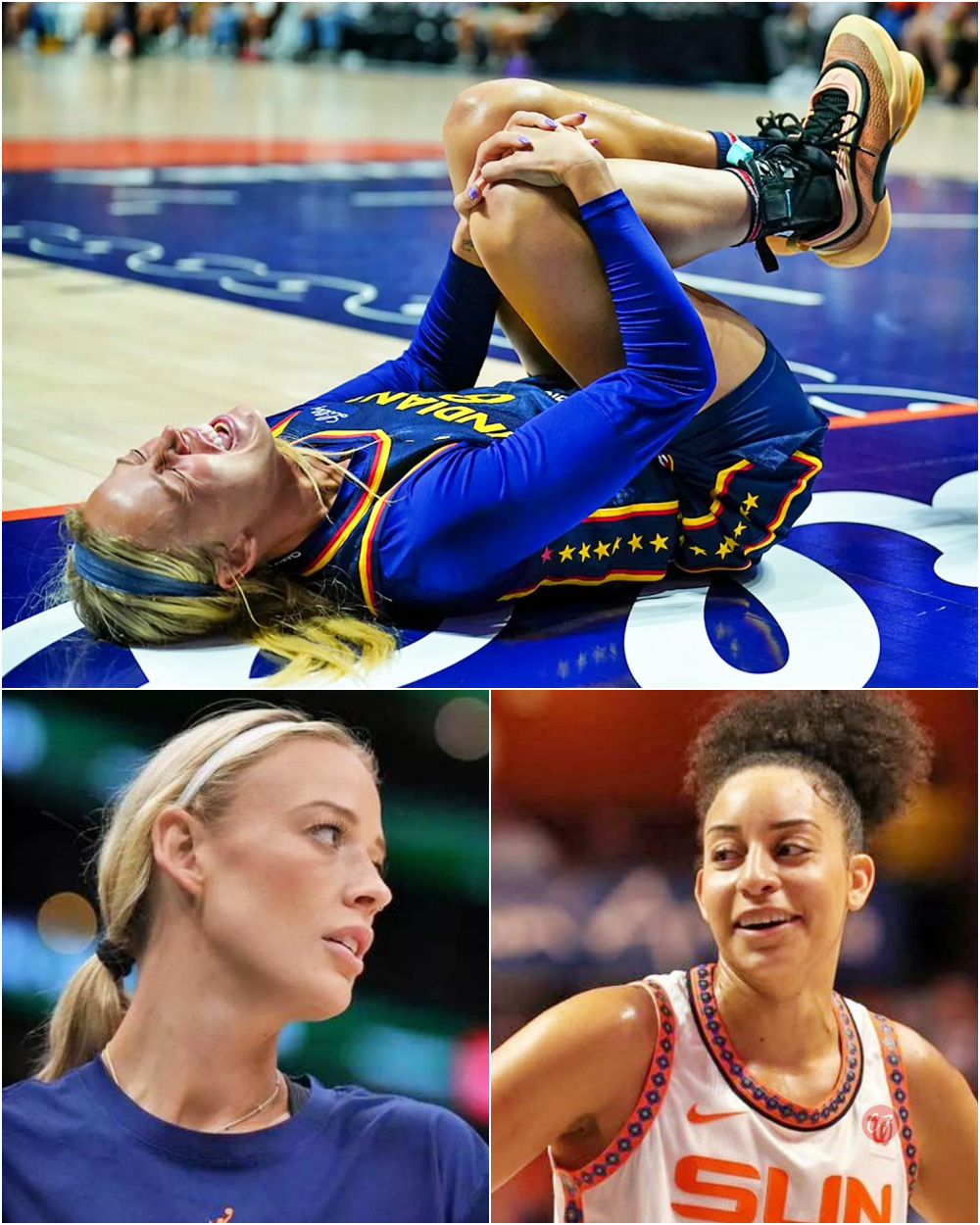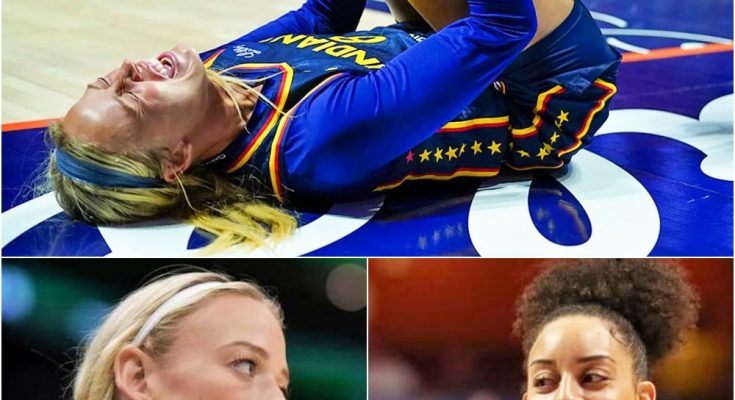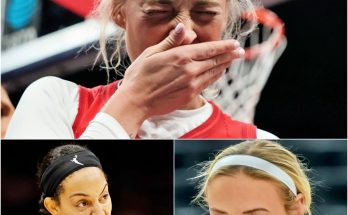
A photo that looked ordinary detonated online. One frame — and nothing felt ordinary anymore.
It came from a routine broadcast angle inside Mohegan Sun Arena on August 17, 2025, during what should have been just another midseason game between the Indiana Fever and the Connecticut Sun. Yet in that frozen instant, captured by a moving camera, the entire league felt like it had been jolted awake.
At first glance, it seemed harmless. A blur of players, a stumble, the chaos of the second quarter. But when fans clipped a still image and pushed it onto social media, the reaction was immediate and merciless. Within hours, it had become the only thing anyone could talk about.
The game itself had already been unusually physical. Elbows collided. Drives to the rim resembled collisions on asphalt. Every possession seemed heavier than the scoreboard suggested. Sophie Cunningham, long celebrated for her relentless style, looked born for nights like these. She had built her career on grit, on diving for balls others wouldn’t touch, on clapping in an opponent’s face.
And then came the moment.
With 8:09 left in the second quarter, Bria Hartley cut across the paint. Sophie stepped in. Their hips brushed, their balance shifted. Sophie’s right knee bent awkwardly. The sound of her fall — a sharp, unmistakable thud against polished wood — swallowed the cheers in the building.
For a second, the crowd gasped. Row 3 swore they could hear her breath snap. Then everyone waited: for a whistle, for a review, for someone to stop the game.
Nothing came.
No whistle. No stoppage. No review.
The Connecticut Sun continued their possession while Sophie clutched her knee, being helped off in silence.
Hours later, the Fever dropped the news like a hammer: Sophie Cunningham would miss the remainder of the season.
The announcement was only one sentence long. Cold. Final.
And almost immediately after, another release: the Fever had signed Shay Petty to a seven-day hardship contract.
Paperwork cleared faster than empathy. By the next morning, a new jersey was printed. The old heartbeat was gone.
Then came the photo.
Cut from the broadcast feed, circulating late that night, one frame spread across social media: Sophie collapsed, Hartley in the background. And the image looked wrong.
Was it a smile? A grimace? A split-second of bad timing? Or something colder?
Fans didn’t agree — but they didn’t need to. The ambiguity itself was enough to ignite a storm.
“Evil.” “Heartless.” “Calculated.” Thousands of comments painted Hartley as a villain. Others fought back, insisting the frame was misleading. But by then it no longer mattered. The photo had gone viral.
Within hours, hashtags flooded X: #ProtectSophie, #ViralPhoto, #WhereWasTheWhistle.
The clip of the collision racked up millions of views. Fan accounts slowed it down frame by frame, circling Hartley’s expression, amplifying the debate. Some called it malice. Others called it chance. The only thing everyone agreed on: the whistle never came.
At a bar in Indianapolis, the music cut mid-beat when the replay flashed on the screen. Nobody spoke. One fan typed three words into their phone: “Protect. Your. Players.” Within minutes it was everywhere.
Talk radio hosts opened their lines. Callers vented. One compared the silence to betrayal. Another asked why the league seemed more interested in replacing Sophie than protecting her.
And then Sophie’s family stepped in.
Her sister retweeted a furious post that blasted the WNBA:
“Maybe you should focus less on fining players for comments and more on hiring officials who can actually protect your athletes. Pathetic.”
Her mother reportedly went further, calling the play “out of control” and “a disgrace.”
The words weren’t polished, but they cut sharper than any official statement. And they spread faster, too.
Meanwhile, from the league office? Nothing.
No disciplinary review. No suspension. No acknowledgement.
A caption replaced a person.
That silence, more than the collision, enraged fans. It was one thing to lose a player to injury. It was another to see the league act like nothing happened.
What made it worse was who Sophie Cunningham was. For years, she had been more than just a guard. She was identity. She was grit and grin, chaos and composure. The one who dove onto hardwood, who stared down rivals, who played like every second mattered.
She wasn’t just in the Fever’s lineup. She was their fire.
Now she was gone. Not with ceremony. Not with justice. Just gone.
“You can’t replace fire with paper,” one viral comment read.
By Monday, the storm had spilled beyond the WNBA. Debate shows on ESPN, FS1, and countless podcasts plastered the viral photo on screen. Analysts argued. Fans screamed online.
Was it an accident? A cruel coincidence? Or had Hartley done something intentional?
The ambiguity made it worse. The image wasn’t proof of anything — and that was exactly why it burned so deeply. Everyone saw what they wanted to see. And nobody could agree.
Inside the Fever’s own film room the next day, the clip froze on the moment of contact. The room stayed quiet. Nobody spoke first.
At the same time, fans on X were demanding action. “Suspend her.” “Explain this.” “Protect your stars.”
But from the commissioner? Silence.
For many, the viral photo became more than a meme. It became a mirror.
To fans, it symbolized everything broken: that fiery stars are celebrated until they fall, and then discarded like paperwork. That protection is marketed, not practiced.
The games will continue. Shay Petty will put on the jersey, run the offense, and play her minutes. But for fans, nothing feels resolved.
Trust doesn’t heal on a seven-day contract.
The photo spread. The questions multiplied. And the silence stayed.
Disclaimer: This article has been compiled from multiple reports, broadcast footage, and widespread online discussions available at the time of publication. Certain descriptions are presented in a narrative style to reflect the intensity of public reaction. The content represents the atmosphere of ongoing debate and commentary, not an official statement from the league or involved parties.



